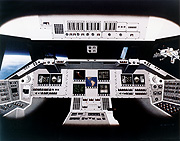
Caldwell credits her track coach, the late Benny Brown, with her toughness during wilderness excercises, like the one above.
During her college career, Caldwell was a member of the Titan women’s track team, where she ran sprints and competed in the long jump. She was named a Big West Scholar Athlete in 1989-91. It was then she met the late Benny Brown, a coach who inspired her to run a second or two faster, or stretch her jumps by another inch or two. Caldwell says she often remembers Brown’s words of encouragement during rigorous survival treks and the demanding physical training that astronauts must endure. Inspired by the optimism of her professors, Caldwell pursued a Ph.D. in chemistry at UC Davis, where she completed the doctoral program in three years and earned the Outstanding Doctoral Student Award. Her dissertation, dedicated to Coach Brown, focused on investigating molecular-level surface reactivity and kinetics of metal surfaces using electron spectroscopy, laser desorption and Fourier transform mass spectrometry techniques.
Caldwell also taught general chemistry laboratory sessions to undergraduate students while pursuing her graduate degree. It was that experience that crystallized her appreciation for her own undergraduate studies. “I blasted through my doctoral program at UC Davis because of the training I received at Cal State Fullerton.” She went on to receive a number of important awards, including the Camille and Henry Dreyfus Postdoctoral Fellowship in Environmental Science. But the biggest prize was yet to come.
Tracy Caldwell investigated the astronaut program the way a scientist would scrutinize a chemical substance. She visited the Space Center in Houston. She conducted research. She weighed the pros and cons.
Among the pros: A sense of camaraderie “that makes you want to stay there.”
And chief among the cons: Long stays away from her family.
While others might put “danger” at the top of their “con” lists, Caldwell figured she already had spent a lot of time working with high-voltage equipment and dangerous, explosive materials and considered those bigger risks than space travel.


